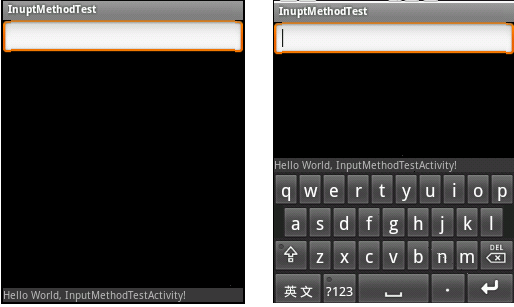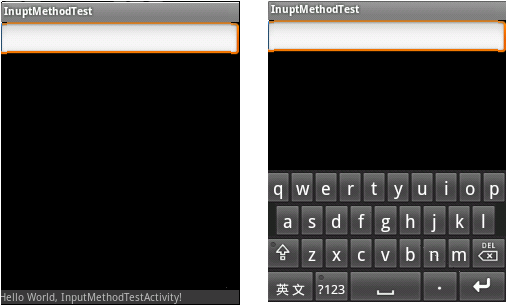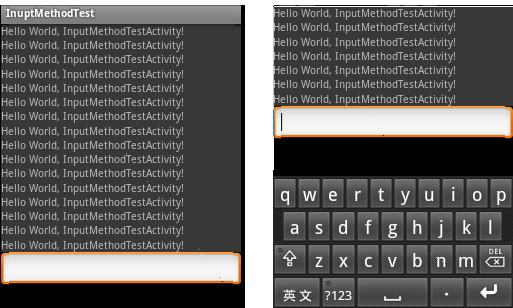您好,登錄后才能下訂單哦!
您好,登錄后才能下訂單哦!
本篇文章為大家展示了如何在Android項目中顯示與隱藏軟鍵盤,內容簡明扼要并且容易理解,絕對能使你眼前一亮,通過這篇文章的詳細介紹希望你能有所收獲。
一、軟鍵盤顯示的原理
軟件盤的本質是什么?軟鍵盤其實是一個Dialog!
InputMethodService為我們的輸入法創建了一個Dialog,并且將該Dialog的Window的某些參數(如Gravity)進行了設置,使之能夠在底部或者全屏顯示。當我們點擊輸入框時,系統對活動主窗口進行調整,從而為輸入法騰出相應的空間,然后將該Dialog顯示在底部,或者全屏顯示。
二、活動主窗口調整
android定義了一個屬性,名字為windowSoftInputMode, 用它可以讓程序可以控制活動主窗口調整的方式。我們可以在AndroidManifet.xml中對Activity進行設置。如:android:windowSoftInputMode="stateUnchanged|adjustPan"
該屬性可選的值有兩部分,一部分為軟鍵盤的狀態控制,另一部分是活動主窗口的調整。前一部分本文不做討論,請讀者自行查閱android文檔。
模式一,壓縮模式
windowSoftInputMode的值如果設置為adjustResize,那么該Activity主窗口總是被調整大小以便留出軟鍵盤的空間。
我們通過一段代碼來測試一下,當我們設置了該屬性后,彈出輸入法時,系統做了什么。
重寫Layout布局:
public class ResizeLayout extends LinearLayout{
private static int count = 0;
public ResizeLayout(Context context, AttributeSet attrs) {
super(context, attrs);
}
@Override
protected void onSizeChanged(int w, int h, int oldw, int oldh) {
super.onSizeChanged(w, h, oldw, oldh);
Log.e("onSizeChanged " + count++, "=>onResize called! w="+w + ",h="+h+",oldw="+oldw+",oldh="+oldh);
}
@Override
protected void onLayout(boolean changed, int l, int t, int r, int b) {
super.onLayout(changed, l, t, r, b);
Log.e("onLayout " + count++, "=>OnLayout called! l=" + l + ", t=" + t + ",r=" + r + ",b="+b);
}
@Override
protected void onMeasure(int widthMeasureSpec, int heightMeasureSpec) {
super.onMeasure(widthMeasureSpec, heightMeasureSpec);
Log.e("onMeasure " + count++, "=>onMeasure called! widthMeasureSpec=" + widthMeasureSpec + ", heightMeasureSpec=" + heightMeasureSpec);
}xml:
<com.winuxxan.inputMethodTest.ResizeLayout xmlns:android="http://schemas.android.com/apk/res/android" android:id="@+id/root_layout" android:layout_width="fill_parent" android:layout_height="fill_parent" android:orientation="vertical" > <EditText android:layout_width="fill_parent" android:layout_height="wrap_content" /> <LinearLayout android:id="@+id/bottom_layout" android:layout_width="fill_parent" android:layout_height="fill_parent" android:orientation="vertical" android:gravity="bottom">s <TextView android:layout_width="fill_parent" android:layout_height="wrap_content" android:text="@string/hello" android:background="#77777777" /> </LinearLayout> </com.winuxxan.inputMethodTest.ResizeLayout>
AndroidManifest.xml的Activity設置屬性:android:windowSoftInputMode = "adjustResize"
運行程序,點擊文本框,查看調試信息:
E/onMeasure 6(7960): =>onMeasure called! widthMeasureSpec=1073742144, heightMeasureSpec = 1073742024 E/onMeasure 7(7960): =>onMeasure called! widthMeasureSpec=1073742144, heightMeasureSpec = 1073742025 E/onSizeChanged 8(7960): =>onSizeChanged called! w=320,h=201,oldw=320,oldh=377 E/onLayout 9(7960): =>OnLayout called! l=0, t=0,r=320,b=201
從調試結果我們可以看出,當我們點擊文本框后,根布局調用了onMeasure,onSizeChanged和onLayout。
實際上,當設置為adjustResize后,軟鍵盤彈出時,要對主窗口布局重新進行measure和layout,而在layout時,發現窗口的大小發生的變化,因此調用了onSizeChanged。
從下圖的運行結果我們也可以看出,原本在下方的TextView被頂到了輸入法的上方。

模式二,平移模式
windowSoftInputMode的值如果設置為adjustPan,那么該Activity主窗口并不調整屏幕的大小以便留出軟鍵盤的空間。相反,當前窗口的內容將自動移動以便當前焦點從不被鍵盤覆蓋和用戶能總是看到輸入內容的部分。這個通常是不期望比調整大小,因為用戶可能關閉軟鍵盤以便獲得與被覆蓋內容的交互操作。
上面的例子中,我們將AndroidManifest.xml的屬性進行更改:android: windowSoftInputMode = "adjustPan"
重新運行,并點擊文本框,查看調試信息:
E/onMeasure 6(8378): =>onMeasure called! widthMeasureSpec=1073742144, heightMeasureSpec=1073742200 E/onMeasure 7(8378): =>onMeasure called! widthMeasureSpec=1073742144, heightMeasureSpec=1073742201 E/onLayout 8(8378): =>OnLayout called! l=0, t=0,r=320,b=377
我們看到:系統也重新進行了measrue和layout,但是我們發現,layout過程中onSizeChanged并沒有調用,這說明輸入法彈出前后并沒有改變原有布局的大小。
從下圖的運行結果我們可以看到,下方的TextView并沒有被頂到輸入法上方。

事實上,當輸入框不會被遮擋時,該模式沒有對布局進行調整,然而當輸入框將要被遮擋時,窗口就會進行平移。也就是說,該模式始終是保持輸入框為可見。如下圖,整個窗口,包括標題欄均被上移,以保證文本框可見

模式三 自動模式
當屬性windowSoftInputMode被設置為adjustUspecified時,它不被指定是否該Activity主窗口調整大小以便留出軟鍵盤的空間,或是否窗口上的內容得到屏幕上當前的焦點是可見的。系統將自動選擇這些模式中一種主要依賴于是否窗口的內容有任何布局視圖能夠滾動他們的內容。如果有這樣的一個視圖,這個窗口將調整大小,這樣的假設可以使滾動窗口的內容在一個較小的區域中可見的。這個是主窗口默認的行為設置。
也就是說,系統自動決定是采用平移模式還是壓縮模式,決定因素在于內容是否可以滾動。
上述內容就是如何在Android項目中顯示與隱藏軟鍵盤,你們學到知識或技能了嗎?如果還想學到更多技能或者豐富自己的知識儲備,歡迎關注億速云行業資訊頻道。
免責聲明:本站發布的內容(圖片、視頻和文字)以原創、轉載和分享為主,文章觀點不代表本網站立場,如果涉及侵權請聯系站長郵箱:is@yisu.com進行舉報,并提供相關證據,一經查實,將立刻刪除涉嫌侵權內容。